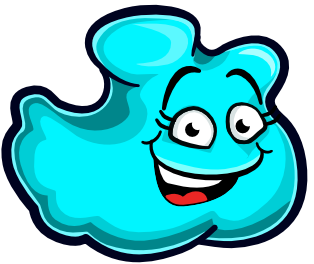
Learn the fascinating science of protein
degradation with our computer game
Have fun exploring the mechanisms of protein degradation in our educational computer game and discover the science behind the ubiquitin-proteasome system that eliminates abnormal proteins in our cells. Learn also about targeted protein degradation, an innovative method of destroying pathogenic proteins using our own cellular degradation pathways.
Join us to learn, play, and uncover the secrets of cellular life!
Protein degradation
Discover the science behind the destruction of proteins and its implications for cell function and new therapies
The Art Of Keeping Balance

Proteins are molecules responsible for performing many essential functions in the cell. Their formation begins with the transcription of DNA into messenger RNA (mRNA) in a process called transcription. The synthesized mRNA molecule then serves as a template for protein synthesis, termed translation, which takes place with the help of ribosomes. During translation, amino acids combine into a polypeptide chain, which forms a functional protein structure. A human cell can produce up to approximately 20,000 different proteins.
Maintaining protein homeostasis (equilibrium) requires efficient mechanisms for protein degradation. Every protein persists in a cell for a certain period, from seconds to minutes or even years. However, proteins can form incorrectly or contain the wrong amino acids, making their timely and accurate removal essential for proper cell function. The main pathway responsible for protein degradation is the ubiquitin-proteasome system (UPS).


Ubiquitin-Proteasome System

In our game, we show the functioning of the ubiquitin-proteasome system (UPS). It involves a cascade of enzymes that includes E1, the ubiquitin-activating enzyme; E2, the ubiquitin-conjugating enzyme; and E3, the ubiquitin ligase, which work together to attach ubiquitin to the target protein. This process, called ubiquitination, results in proteins being recognized and then degraded by the proteasome. The proteasome acts as a cellular recycling center, breaking down ubiquitin-tagged proteins into short amino acid chains that can be reused by the cell to, for example, synthesize new proteins.
The UPS plays an important role in maintaining protein homeostasis by controlling protein levels and eliminating those that are unwanted. In this way, it regulates various molecular processes, such as the cell cycle, signal transduction, and DNA repair. Mutations of UPS components can lead to protein accumulation, disrupt cellular functions, and contribute to the development of various diseases, including cancer, Alzheimer’s disease, and Parkinson’s disease.
Targeted Protein Degradation - The Future Of Medicine?

What if we could harness our ubiquitin-proteasome system and tailor it to remove toxic disease-causing proteins? Well, this is no longer science fiction – it is how modern targeted protein degradation (TPD) therapies work. The strategy is simple; scientists design compounds that allow E3 ligases to bind proteins that they don’t normally recognize. The E3 ligases then bring them to E2 enzymes, resulting in ubiquitination of the proteins and degradation by the proteasome.
The two main classes of compounds using targeted protein degradation mechanisms are molecular glues and PROTACs. Molecular glues are small molecules that enhance interactions between an E3 ligase and a selected protein, while PROteolysis TArgeting Chimera (PROTAC) compound consist of two parts – one recognizes a specific E3 ligase, and the other recognizes the selected target protein.
Molecular glues, for example, lenalidomide or pomalidomide, have already achieved clinical success and are used to treat cancers such as multiple myeloma. Several PROTAC compounds are currently in advanced clinical trials against breast or prostate cancers, among others. TPD methods make it possible to destroy disease-causing proteins, including oncogenic proteins, and hold great promise for a wide range of therapeutic applications.

Game characters
Meet the awesome characters from the game!
E3 ubiquitin ligase

The main character of the game. Its goal is to recognize other proteins (substrates) and mediate their ubiquitination which leads to their subsequent destruction.
E2 ubiquitin-conjugating enzyme

The best companion of the E3 ubiquitin ligase. Forms a complex with it and transfers ubiquitin to the target protein.
Substrates

Different proteins, but one goal: tag them with ubiquitin and send for degradation.
Ubiquitin

Gray eminence of the game. Its attachment to the target protein acts as a "destroy me" signal for the proteasome.
Proteasome

Large molecular complex that functions as a cellular recycling center. Recognizes and destroys ubiquitinated proteins.
Deubiquitinating enzyme

Major antagonist. Removes ubiquitin from proteins, preventing their degradation.
Also featuring...
PROTAC (PROteolysis TArgeting Chimera)

For educators
Our game was created with a primary focus on education, as we believe there’s no better way to learn than through having fun. To enrich the journey into the fascinating world of protein degradation, we have prepared a range of downloadable materials to enhance the learning experience and complement the knowledge gained from our game.
Lesson plan (age 15+)
Biology lesson concept for high schools/secondary schools.
Lesson plan (age 12-15)
Biology lesson concept for the older grades of elementary school.
Presentation
An editable PowerPoint multimedia presentation for use in a biology lesson.
Quizzes
Quizzes about protein degradation based on the Great Encyclopedia of Protein Degradation.
Comic
A comic depicting the further adventures of ubiquitin ligase E3 and friends.
Levels description
Detailed description of the game, its characters and each of its levels.
Authors

NATALIA
SZULC

ANNA
OLCHOWIK

PATRYCJA JASZCZAK

BARTOSZ JANIAK

WOJCIECH POKRZYWA
Publication
Available soon!
Acknowledgments
This educational computer game was funded in Poland in part by the Polish State Budget, under the Ministry of Education and Science program entitled the Social Responsibility of Science – grant number SONP/SP/546507/2022; funded amount: 101 706 PLN; total grant value: 115 756 PLN.


Game partners



